Top 5 articles regarding robots in 2009
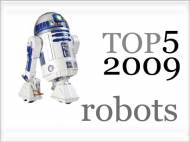 Contrary to the popular opinion, Karel Capek, the author of RUR is not the inventor of the word robot. The word which is derived from the Czech noun “robota” meaning “labor” is an accomplishement of Capek’s older brother, the cubist painter and writer Josef Capek. Today, robots are becoming widely applied for medical, military, exploring, aiding, entertainment and industrial porpoises.
Contrary to the popular opinion, Karel Capek, the author of RUR is not the inventor of the word robot. The word which is derived from the Czech noun “robota” meaning “labor” is an accomplishement of Capek’s older brother, the cubist painter and writer Josef Capek. Today, robots are becoming widely applied for medical, military, exploring, aiding, entertainment and industrial porpoises.
Here are the 5 most popular articles according to our visitors:
5. SQUSE’s robot hand designed to handle fragile goods
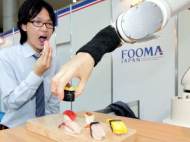 Although it resembles a lifelike hand in a great degree, its main application isn’t aimed at prosthetics. Kyoto-based factory automation company Squse has developed a robotic hand that is dexterous and delicate enough to handle sushi. It is available in two variations. One is more human resembling (H type, image left) and the other (G type, image right) is mounted on a base and resembles industrial robots.
Although it resembles a lifelike hand in a great degree, its main application isn’t aimed at prosthetics. Kyoto-based factory automation company Squse has developed a robotic hand that is dexterous and delicate enough to handle sushi. It is available in two variations. One is more human resembling (H type, image left) and the other (G type, image right) is mounted on a base and resembles industrial robots.
It is made of a polycarbonate skeleton covered by a skin which is made of soft silicone. The skeleton part itself weights only 220g, while the silicone skin weights 120g. It can lift up to 1kg (or 1.5kg, depending on the shape of the object it manipulates).
4. Aid robot Hina – not so helpful but it tries really hard
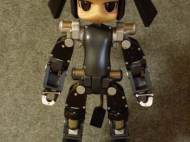 After the production of many robotic toys has been stopped, we lost our faith in the current development of miniaturized humanoid robots. Besides the fact they are very entertaining, they could also be programmed to help us in simple everyday tasks. The fact that these robots are wanted is proved by a video posted a few days ago. It is a video about a small humanoid robot nicknamed Hina (although the robot creator claims it doesn’t have a name yet).
After the production of many robotic toys has been stopped, we lost our faith in the current development of miniaturized humanoid robots. Besides the fact they are very entertaining, they could also be programmed to help us in simple everyday tasks. The fact that these robots are wanted is proved by a video posted a few days ago. It is a video about a small humanoid robot nicknamed Hina (although the robot creator claims it doesn’t have a name yet).
It is a little robot that makes coffee: preparing the cups and dripper, grinding the beans, filtering the coffee and pouring the finished product into a cup. The little humanoid robot is a creation of Mujaki and is based on Kondo’s KHR-2HV. Despite the fact the video was staged (since the robot is able to perform a great amount of sequences it was programmed to do), the popularity and positive response of people around the world show that companies shouldn’t stop the development and production of similar robots.
3. Stenzel HeXoR II – a teaching aid for schools and research institutions
 The Stenzel Ltd. from Poland is a unique commercial-scientific venture in the Central Europe area. They are developing HeXoR, a mobile didactic robot which has been designed as a teaching aid for schools and research institutions. It can be lots of fun if you are an enthusiast, who is keen on robotics, informatics and electronics issues. The robot is modular hence it is possible to add new features like a compass, motion detector, light intensity sensor, different gas concentration sensors and noise level intensity sensors.
The Stenzel Ltd. from Poland is a unique commercial-scientific venture in the Central Europe area. They are developing HeXoR, a mobile didactic robot which has been designed as a teaching aid for schools and research institutions. It can be lots of fun if you are an enthusiast, who is keen on robotics, informatics and electronics issues. The robot is modular hence it is possible to add new features like a compass, motion detector, light intensity sensor, different gas concentration sensors and noise level intensity sensors.
HeXoR II is their current top model which is a unique combination of a six-legged platform, driven by means of DC servo-mechanisms, with a modern microprocessor controller and a set of sensors and data acquisition systems from the robot’s environment. It’s provided with the basic software which controls the robot. Basing on the supplied software in BASIC, the user may create his own programs in assembler or C language.
2. BigDog – a rough-terrain robot
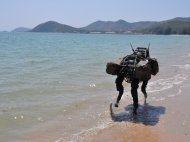 BigDog is a legged robot under development of BostonDynamics, with funding from DARPA. Their goal is to build unmanned legged vehicles with rough-terrain mobility superior to existing wheeled and tracked vehicles. The idea system would travel anywhere a person or animal could go using their legs, run for many hours at a time, and carry its own fuel and payload. It would be smart enough to adapt its posture and behavior according to the terrain with minimum human guidance and intervention.
BigDog is a legged robot under development of BostonDynamics, with funding from DARPA. Their goal is to build unmanned legged vehicles with rough-terrain mobility superior to existing wheeled and tracked vehicles. The idea system would travel anywhere a person or animal could go using their legs, run for many hours at a time, and carry its own fuel and payload. It would be smart enough to adapt its posture and behavior according to the terrain with minimum human guidance and intervention.
The BigDog robots have taken steps toward these goals, though there remains a great deal of work to be done. BigDog weighs about 109kg, is about 1 meter tall, 1.1 meters long, and 0.3m wide. In separate tests BigDog runs at 6.5 kilometers per hour and climbs slopes up to 35 degrees. It is able to walk across rubble, climb a muddy hiking trail, walk in snow and water, and is able to carry a 155kg load. BigDog set a world’s record for legged vehicles by traveling 20.5 kilometers without stopping or refueling.
1. Panasonic Fukitorimushi scrubs the floor while you sleep
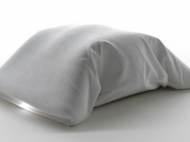 Fukitorimushi is an autonomous floor-cleaning robot that crawls like an inchworm and uses a super-absorbent nanofiber cloth to wipe up microscopic dust and residue that ordinary vacuums leave behind. Unveiled at the recent Tokyo Fiber Senseware exposition in Milan, Fukitorimushi (scrubbing bug) is designed by Panasonic and incorporates nanofiber technology developed by textile maker Teijin, Ltd. Although many described it as a competition to popular cleaning robots like Roomba or Scooba from iRobot, it actually isn’t as you’ll notice by further reading of the article.
Fukitorimushi is an autonomous floor-cleaning robot that crawls like an inchworm and uses a super-absorbent nanofiber cloth to wipe up microscopic dust and residue that ordinary vacuums leave behind. Unveiled at the recent Tokyo Fiber Senseware exposition in Milan, Fukitorimushi (scrubbing bug) is designed by Panasonic and incorporates nanofiber technology developed by textile maker Teijin, Ltd. Although many described it as a competition to popular cleaning robots like Roomba or Scooba from iRobot, it actually isn’t as you’ll notice by further reading of the article.
The robot cleans by dragging its nanocloth belly across the floor. It crawls around slowly in search for dirt and is rather silent (comparing to its “competition”). Fukitorimushi, moves around by flexing and stretching its body like an inchworm. It uses “feelers” of blue-white light to search for dirty spots. When it finds dirt, the robot emits a red light and devotes extra effort to cleaning that area. After it finishes the cleaning, the machine returns to its charging station to recharge its battery.









Leave your response!